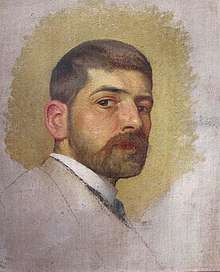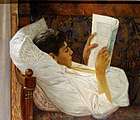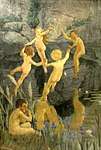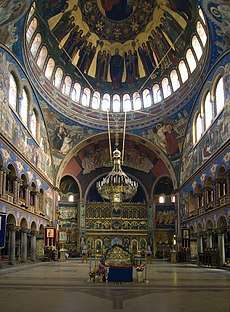Octavian Smigelschi
| Octavian Smigelschi | |
|---|---|
 Self-portrait | |
| Born |
March 21, 1866 Nagyludas, Szeben County, Austrian Empire (Principality of Transylvania) |
| Died |
November 10, 1912 (aged 46) Budapest, Transleithania, Austria-Hungary |
| Resting place | Blaj, Romania |
| Nationality | Austro-Hungarian (Romanian) |
| Alma mater | Drawing School and Art Teachers' College |
| Known for | Mural art, printmaking, modelli, icon painting |
| Notable work | Interior painting at Sibiu Orthodox Cathedral |
| Movement | Romanticism, Naturalism, Academic art, Symbolism, Art Nouveau, Luceafărul |
| Awards |
Romanian Expo prize for icon painting (1906) Vilmos Fraknói (1907) |
Octavian or Octav Smigelschi (last name also Smigelski, Smighelschi, Szmigelszki, or Szmigelschi; Hungarian: Szmigelszki Oktáv; March 21, 1866 – November 10, 1912) was an Austro-Hungarian painter and printmaker, one of the leading culturally Romanian artists in his native Transylvania. Of mixed Polish, Aromanian, and possibly Ruthenian, background, he identified mainly with the Romanian-speaking Greek-Catholics, although some of his most important work was also done for the rival Romanian Orthodox Church. Smigelschi graduated from the Drawing School and Art Teachers' College in Budapest, working on and off at high schools in Upper Hungary and Transylvania. His European journeys with Arthur Coulin took him to Cervara di Roma, where he studied Renaissance art, while moving away from academic art and into Symbolism and Art Nouveau.
Modernizing themes from Romanian folklore and Byzantine art, from 1903 Smigelschi focused his effort mainly on Christian art and modelli, including initial work for decorating Blaj Cathedral. He was among those commissioned to paint Sibiu Orthodox Cathedral, which required him to study religious art in the neighboring Kingdom of Romania. His "new vision" combined elements of Symbolism into the Orthodox tradition—a synthesis also found in his murals for smaller churches throughout Transylvania, and in his work on icons. His contribution was relatively ignored in Romania, but well-liked in Transylvania and Transleithania at large, earning Smigelschi the Vilmos Fraknói prize in 1907. He died of a heart disease while he was preparing to focus his work on Hungarian churches.
Biography
Background and early life
The artist's father, Mihail Śmigielski, came from Partitioned Poland. According to historian Nicolae Iorga, the family descended from chorąży (standard-bearers) to the Polish king.[1] Another writer suggests a Ruthenian background; Mihail was an Eastern-rite Catholic, and the Austrian Partition of Poland was home to numerous Ruthenian Greek-Catholics. However, he does allow for the possibility that the elder Smigelschi adopted the faith after arriving in Transylvania.[1] Octavian Smigelschi's own ethnic identity has been subject to some debate, with both Polish and Hungarian suggested, but he considered himself as Romanian,[2] and was described by Transylvanians as the region's "only Romanian painter."[3]
Mihail was a member of the szlachta noble class who fled Poland following the 1848 Revolution and arrived in the Principality of Transylvania in 1850.[4] Initially settling in Bungard, he married Ana Sebastian, an Aromanian from Macedonia and also a Greek-Catholic.[5] Later, he moved to Nagyludas in Szeben County, now Ludoș, Sibiu County, to work as a notary. There, he had four sons. One of them, Victor, obtained a Theology doctorate from the University of Vienna, teaching the subject and serving as a canon in Blaj. Another, Vasile, became an architect and was influenced by Romanian nationalism.[6] Mihail's other son, Cornel Smigelschi, died in 1892, an event which inspired Octavian to paint a number of portraits from memory, and also to produce a series of drawings and canvasses of Abaddon.[7] Cornel is depicted in the 1892 "Young Man Reading".[8]
Octavian began school in his native village, and in 1880 enrolled at the state Hungarian high school in Sibiu. There, he became close friends with Fritz Schullerus, and the two took art classes from Carl Dörschlag, a German immigrant. Following graduation in 1884, he obtained a public scholarship to study at the Drawing School and Art Teachers' College in Budapest, headed by Bertalan Székely, together with Schullerus.[9] He completed his work there in 1889.[10] The following year, he applied for a scholarship in Romania, explaining that Hungary was stifling his creativity.[11] He was finally integrated by the Hungarian education system, and named art teacher in the Upper Hungarian (Slovak) town of Banská Štiavnica.[9]
Also in 1890, he held his first exhibition in Sibiu, alongside Schullerus and another Transylvanian Saxon colleague. In 1892, he was hired to teach art at the state high school in Dumbrăveni. He held this position until 1911, when he retired in order to focus on painting, although from 1905, when he moved to Sibiu, he was on a leave of absence for the same reason.[12] During that interval, he began painting icons, which he advertised as "the only ones befitting our canon."[3] Together with his brother Victor, Smigelschi also joined the Blaj chapter of ASTRA Society, a Romanian nationalist association.[13]
As described by art historian Gheorghe Vida, Smighelschi's other work of the period is a transition from Romanticism to Symbolism, with frequent lapses into Naturalism and academic art. Specifically, he belongs to the branch of Symbolism cultivated by Dörschlag, Hans von Marées, Pierre Puvis de Chavannes, Max Klinger, and Béla Iványi-Grünwald.[14] Art historian Mihai Ispir views Dörschlag and Smigelschi as the two benchmarks of a transition from "the neoclassical 'ideal' to Symbolist 'idealism'."[15] Curators Sabin-Adrian Luca and Dana-Roxana Hrib describe Smigelschi's painting as bridging "temperate naturalism" and "influences from that branch of Symbolism which descends from German romanticism."[8] As the 1890s went on, Smigelschi also became increasingly drawn to Art Nouveau.[16] Beginning in 1898, he undertook trips to Munich, Dresden, Vienna, Budapest, Florence, Rome and Ravenna, studying the local Renaissance art.[17] He bunked with Robert Wellman and Arthur Coulin at Cervara di Roma art colony.[18] Following this sojourn, Smigelschi expanded his Symbolist range. Initially, his paintings of Abbadon became more macabre; circa 1900, however, Smigelschi introduced a merrier derivation of Symbolism, exploring the motif of "wicked fairies", which has roots in Romanian folklore.[19]
In 1903, he held his second exhibition in Blaj, featuring exclusively religious works, including modelli for painting the Greek-Catholic cathedral. That October, his third exhibition took place in Sibiu, with 71 secular paintings and drawings.[20] Among the displays was a 7 x 5 m carpet woven by peasant women from Maramureș based on his indications. The show drew universal acclaim due to the newness of his style and the combination of popular Romanian motifs and peasant folk art he employed. The fourth exhibition occurred the same year in Budapest, and was praised as well, including by Octavian Goga in Luceafărul.[21]


_1904.png)


Sibiu cathedral and later years
Meanwhile, the old Romanian Orthodox cathedral in Sibiu had been demolished in 1902 and a new building begun.[20] A competition for the painting opened in November 1903, with fifteen Romanian, German and Hungarian participants.[22] A committee composed of George Demetrescu Mirea, Ion Mincu and Friedrich Miess narrowed the field down to three finalists. In April 1904, Smigelschi was selected to execute the interior painting.[23] He was paid 32,000 crowns for the cupola, the pendentives and the iconostasis.[24] At this time, he began to focus on traditional styles of painting, seeking to strike a balance between large-scale murals and the architectural surroundings which they were not supposed to overshadow. Accordingly, in 1904, he crossed into the Romanian Old Kingdom as well as the Duchy of Bukovina in order to study the churches and monasteries where the Romanians' spiritual heritage is expressed,[23] familiarizing himself with the Byzantine style that came to complement his knowledge of Renaissance painting.[10] Reportedly, his interest in Byzantine art had first manifested itself in Italy, when he sketched after the monuments of Ravenna.[25]
In this second creative period, Smigelschi nearly abandoned all other genres in favor of monumental work.[8] He analyzed old painted churches at Tismana, Cozia, Bistrița, Horezu, Curtea de Argeș, Bucharest, Snagov, Sinaia, Iași, Suceava, Sucevița, Dragomirna, Putna, Rădăuți, Humor, Voroneț and Cernăuți.[26] His own work, in churches at Șanț, Rădești, Sibiu, Ciacova and elsewhere, reflects attention to tradition but not a mere reproduction thereof. From Byzantine models he took the monumental size and decorative look; this was infused with the Renaissance and German schools, in particular Arnold Böcklin, to create a neo-Byzantine style most evident in the Sibiu cathedral.[27] In a number of Transylvanian churches, particularly in the Năsăud area, he painted icons and sometimes entire iconostases.[10]
After moving to Sibiu in 1905,[24] he was able to complete his commission there by the time the new cathedral was dedicated in May 1906.[28] As a speaker of German and Hungarian, he fit easily into the city's artistic milieu.[16] Features of his cathedral work, which he himself published as prints in Luceafărul,[29] include Christ Pantocrator in the cupola, the Four Evangelists on the pendentives and the painted iconostasis. Romanian folk motifs are used in the clothing worn by the Three Magi, the shepherds and the child angels with the star, while the Nativity of Jesus is transposed to a Romanian setting.[30] Mircea Păcurariu suggests that the Magi are each inspired by a ruler of the Romanian provinces (Moldavia, Wallachia and Transylvania): Alexander the Good is taken from Sucevița, Neagoe Basarab from Curtea de Argeș and Matthias Corvinus from a period engraving.[31]
According to Iorga, Smigelschi persisted in his goal to paint a church of his own in Romania-proper, and presented his designs during the 1906 national exhibit in Bucharest, "the Capital of his People." He was sidelined in favor of "others, better seen and better connected."[32] However, the icons he presented at the exhibit did earn Smigelschi a state prize, worth 250 lei.[33] In 1907, along with painting at Ciacova, he donated funds to the families of those killed during the peasants' revolt. The following year, Smigelschi won a competition for the Vilmos Fraknói prize, guaranteeing him 3000 crowns annually, a studio and a residence in Fraknói's Rome house. He also organized an exhibit in Budapest, drawing favorable mentions in the local press.[34] In 1909, Smigelschi painted the Greek-Catholic church in Rădești. During this time, he began to show symptoms of heart disease that grew progressively worse. He received an order for painting the altar in a Rákóczi chapel in Hungary, which remained unfilled, while painting for the Blaj cathedral and the remainder of the Sibiu cathedral was left in the planning stages.[35]
In his final years, Smigelschi returned to modelli and created a series of mannequins, possibly intending to extend into sculpture. As noted by historian Nicolae Sabău, no buyer encouraged his work in the field.[36] He also intended to execute a triptych for the 1911 International Exhibition of Art in Rome, but this remained undone due to a heart attack. In 1912, with his disease worsening, he left for treatment at Bad Nauheim. He then traveled to Budapest, where he took part in a contest for painting a chapel in Košice. Smigelschi died in Budapest in November 1912.[35] His brother Victor claimed the remains and he was buried in Blaj.[37]
Iorga, in his obituary piece, claimed that both Catholics and Orthodox Transylvanians felt "undying sorrow, [sensing] that a century may pass and another painter like him [...] may still not be born." The deceased, he argued, had instilled a "new vision of the world".[38] Likewise, Octavian Codru Tăslăuanu of Luceafărul writes that Smigelschi's "innovation created a school", although withholding judgment on "whether the innovation was for the better."[29] As asserted by Ispir, Smigelschi's neo-Byzantine approach was a "perishable tear into the threads of tradition". It replaced the "post-Byzantine customs" of traditional church art with a more academic and "historicist" approach.[39]
Retrospective exhibitions before World War I include an October 1913 show at the Budapest Kunsthalle, also honoring Coulin and Bertalan Bartolomaus Papp.[40] Most of Smigelschi's works were bought and preserved by the ASTRA Museum, then transferred to Brukenthal.[41] According to scholar Virgil Vătășianu, the sketches are the artist's most important contributions, and as such the most important artworks produced by a Transylvanian Romanian in the pre-1914 era.[42] The other Smigelschis continued to be active in Romania, following the Transylvanian union. Smigelschi's son, Victor, was an architect noted for designing Blaj's Palace of Culture in 1930,[43] and for his contribution to the Romanian pavilion at EXPO Paris 1937.[44] He married the Italian Maria Anna Giuseppina Trinchieri; their progeny includes two daughters, both of whom are noted artists: ceramist Ioana Șetran and printmaker Ana-Maria Smigelschi.[45]
%2C_1903.png)

Notes
- 1 2 Gogâlea, p. 15
- ↑ Gogâlea, pp. 7, 10. See also Iorga, pp. 59–60
- 1 2 "Cronică. Pictor român", in Foaia Poporuluĭ, Nr. 28/1896, p. 221
- ↑ Oprescu, p. 816; Păcurariu, p. 27
- ↑ Gogâlea, p. 15. See also Oprescu, p. 816
- ↑ Gogâlea, p. 15. See also Iorga, p. 60
- ↑ Vida, pp. 38–39
- 1 2 3 Sabin-Adrian Luca, Dana-Roxana Hrib, Marile muzee ale lumii, 15: Muzeul Național Brukenthal, Sibiu/Hermannstadt, p. 110. Bucharest: Adevărul Holding, 2010. ISBN 978-606-539-253-3
- 1 2 Gogâlea, p. 16
- 1 2 3 Păcurariu, p. 27
- ↑ Gogâlea, p. 7
- ↑ Gogâlea, p. 17
- ↑ "Consemnarea membrilor 'Asociațiunii pentru literatura română și cultura poporului român'. Starea dela 1 Iulie 1903", in Analele Asociațiunii pentru Literatura Română și Cultura Poporului Român, Nr. IV, July 1903, p. 70
- ↑ Vida, pp. 37–39
- ↑ Ispir, p. 153
- 1 2 Gogâlea, p. 11
- ↑ Gogâlea, p. 17; Păcurariu, p. 27; Vida, p. 38
- ↑ Vida, p. 38
- ↑ Vida, pp. 38–40
- 1 2 Gogâlea, p. 18
- ↑ Gogâlea, p. 19
- ↑ Gogâlea, pp. 19–20
- 1 2 Gogâlea, p. 20
- 1 2 Gogâlea, p. 21
- ↑ Tăslăuanu, p. 185
- ↑ Gogâlea, pp. 20–21
- ↑ Gogâlea, pp. 21, 34
- ↑ Gogâlea, pp. 21–22
- 1 2 Tăslăuanu, pp. 184–185
- ↑ Gogâlea, p. 13; Păcurariu, pp. 28, 30
- ↑ Păcurariu, p. 30
- ↑ Iorga, p. 59
- ↑ "Din România. Știri dela expoziție", in Tribuna, Nr. 132/1906, p. 2
- ↑ Gogâlea, p. 22
- 1 2 Gogâlea, p. 23
- ↑ Gogâlea, pp. 32–33
- ↑ Gogâlea, p. 23. See also Iorga, p. 59
- ↑ Iorga, p. 60
- ↑ Ispir, pp. 56–57
- ↑ "Művészet és zene. 1913", in Kincses Kalendáriom 1915-re, p. 180
- ↑ Gogâlea, pp. 32, 33
- ↑ Gogâlea, p. 33
- ↑ The Culture Palace in Blaj, Radio Romania International, May 27, 2017
- ↑ Luminița Machedon, Romanian Modernism: The Architecture of Bucharest, 1920–1940, pp. 301–303. Cambridge: MIT Press, 1999. ISBN 0-262-13348-2
- ↑ (in Romanian) Ioana Șetran, "Confesiuni. Născută pentru a fi ceramistă (I)", in Ziarul Financiar, November 16, 2007; Ana-Maria Smigelschi, "Foileton. Proze-lițe (IV). Numele oamenilor", in Ziarul Financiar, September 14, 2012; Florin Toma, "Când pictorii pun mâna pe condei", in Viața Românească, Nr. 8/2016
References
- (in Romanian) Dorin Gogâlea, "Octavian Smigelschi", Seria Personalia, Nr. 1, Biblioteca Judeţeană ASTRA, Sibiu, 2006.
- Nicolae Iorga, Oameni cari au fost, Vol. II. Bucharest: Editura Fundațiilor Regale, 1935.
- Mihai Ispir, Clasicismul în arta românească. Bucharest: Editura Meridiane, 1984. OCLC 251860309
- (in Romanian) George Oprescu, "Octavian Smigelschi desenator", in Transilvania, Nr. 10–12/1944, pp. 816–820.
- (in Romanian) Mircea Păcurariu, "Pictura lui Octavian Smigelschi din catedrala mitropolitană din Sibiu", in Transilvania, Nr. 4/2006, pp. 27–30.
- Octavian Codru Tăslăuanu, Octavian Goga. Amintiri și contribuții la istoricul Revistei Luceafărul. Partea 1—Epoca budapestană —1902–1906. Bucharest: I. E. Torouțiu, 1939. OCLC 496213768
- (in French) Gheorghe Vida, "Aspects symbolistes dans l'œuvre de quelques artistes de Transylvanie", in Revue Roumaine d'Histoire de l'Art. Série Beaux-arts, Vol. XLIV, 2007, pp. 37–47.
External links
| Wikimedia Commons has media related to Octavian Smigelschi. |